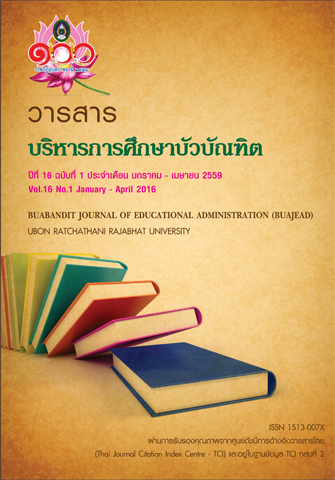การพัฒนาการจัดการเรียนรู้โดยผสานแนวคิดการใช้วิจัยเป็นฐานประกอบกลุ่มร่วมมือ วิชาประวัติศาสตร์ เพื่อส่งเสริมคุณลักษณะการนาตนเองในการเรียนรู้ และการคิดอย่างมีวิจารณญาณของนักเรียนชั้นมัธยมศึกษาปีที่ 3
Main Article Content
บทคัดย่อ
ผลการวิจัย พบว่า
1. การพัฒนาการจัดการเรียนรู้โดยผสานแนวคิดวิจัยเป็นฐานประกอบกลุ่มร่วมมือ วิชาประวัติศาสตร์ เพื่อส่งเสริมคุณลักษณะการนำตนเองในการเรียนรู้และการคิดอย่างมีวิจารณญาณ ของนักเรียนชั้นมัธยมศึกษาปีที่ 3 ประกอบด้วยกิจกรรมการเรียนรู้ 5 ขั้นตอน ได้แก่ 1) ขั้นเผชิญสถานการณ์ และเหตุการณ์ในบทเรียน 2) ขั้นวิเคราะห์ความเชื่อด้วยประสบการณ์พื้นฐาน 3) ขั้นอ้างอิงและเสนอข้อโต้แย้ง 4) ขั้นยอมรับและลงความเห็นในความเชื่อ 5) ขั้นสรุปและนำไปใช้ ซึ่งผลการประเมินคุณภาพและความเหมาะสม ของแผนโดยผู้เชี่ยวชาญ มีค่าเฉลี่ยรายแผนตั้งแต่ 4.45–4.68 และค่าเฉลี่ยโดยรวม เท่ากับ 4.54
2. ผลการจัดการเรียนรู้โดยผสานแนวคิดการวิจัยเป็นฐานประกอบกลุ่มร่วมมือ วิชาประวัติศาสตร์ ของนักเรียนชั้นมัธยมศึกษาปีที่ 3 ปรากฏผลดังนี้
2.1 ประสิทธิภาพสำหรับการจัดการเรียนรู้โดยผสานแนวคิดการวิจัยเป็นฐานประกอบ กลุ่มร่วมมือ วิชาประวัติศาสตร์ มีประสิทธิภาพเท่ากับ 82.01/84.65 ซึ่งสูงกว่าเกณฑ์ 75/75 ที่กำหนดไว้
2.2 ผลการเปรียบเทียบนักเรียนชั้นมัธยมศึกษาปีที่ 3 ที่ได้รับจากการจัดการเรียนรู้โดย ผสานแนวคิดการวิจัยเป็นฐานประกอบกลุ่มร่วมมือ วิชาประวัติศาสตร์ มีการนำตนเองในการเรียนรู้หลังเรียน ( = 67.04 ) สูงกว่าก่อนเรียน (
= 54.49) อย่างมีนัยสำคัญทางสถิติที่ระดับ .05 (t = 11.94*)
2.3 ผลการเปรียบเทียบนักเรียนชั้นมัธยมศึกษาปีที่ 3 ที่ได้รับการจัดการเรียนรู้โดยผสาน แนวคิดการวิจัยเป็นฐานประกอบกลุ่มร่วมมือ วิชาประวัติศาสตร์ มีคะแนนเฉลี่ยความสามารถด้านการคิดอย่างมี วิจารณญาณหลังเรียน ( =33.87) สูงกว่าก่อนเรียน (
= 27.66) อย่างมีนัยสำคัญทางสถิติที่ระดับ .05 (t = 9.64*)
Developing a Learning Activity Combined Between Research-based Learning with Cooperative Learning Approach, for History Content Strand, to Promote Self-directed Learning and Critical Thinking of Matthayomsuksa 3 Students
The purpose of this research were : 1) to develop learning management combined between Research-Based Learning with Cooperative Learning Approach, for History content strand, to promote self-directed learning and critical thinking of Matthayomsuksa 3 students, 2) to study the effects of learning management combined between Research-Based Learning with Cooperative Learning Approach, for History content strand, of Matthayomsuksa 3 students, which were comprised of : 2.1) to study for the efficiency of learning management combined between Research-Based Learning with Cooperative Learning Approach, for History content strand, with the required establishment of 75/75, 2.2) to compare self-directed learning of the students before and after learning with activity combined between Research-Based Learning and Cooperative Learning Approach, 2.3) to compare critical thinking of the students before and after learning with activity combined between Research-Based Learning and Cooperative Learning Approach. The target participants who given the concerned information about learning management in history content were consisted of 2 teachers, and the samples of 112 students for replying questionnaire from Ban Nonghin school and Ban Nonpodaeng school. Whereas, the samples for using learning management combined between Research-Based Learning and Cooperative Learning Approach were 29 students of Ban Nonpodaeng school, who obtained using cluster random sampling technique. The research instruments were comprised of : 1) questionnaire for the students about current state of leaning management in history content, 2) observing form for the classroom learning management, 3) interviewing forms for teachers and students about the state of problems and needs of learning management, 4) plans for learning management combined between Research-Based Learning and Cooperative Learning Approach for history content, for 8 plans with 16 hours, 5) learning achievement test with 25 item of multiple choices and 1 item of subjective test, 6) critical thinking test with 25 item of multiple choices, and 7) handbook for learning management. The statistics used for analyzing data were percentage, mean, standard deviation, and t-test (Dependent sample) was employed for testing hypotheses.
The research findings were as follows:
1. The results of developing for learning management combined Between Research-Based Learning and Cooperative Learning Approach for history content, to enhance self-directed learning and critical thinking of students were consisted of 5 steps as the following : 1) Confronting with learning situations, 2) Analyzing of belief with pre-experiences, 3) Inference and giving argument, 4) Accepting and judging in belief, 5) Concluding and implementing of knowledge. Which, showed quality and appropriateness score, that judged by concerned experts were 4.45-4.68 for each plan, and was 4.54 for overall of plans.
2. The effects of learning management combined between Research-Based Learning and Cooperative Learning Approach for history content for Mathayomsuksa 3 students were as :
2.1 Learning management combined between Research-Based Learning and Cooperative Learning Approach for history content in Mathayomsuksa 3 level had the efficiency of 82.01/84.65, which was higher than the establishment criterion of 75/75.
2.2 The students who provided of learning management combined between Research-Based Learning and Cooperative Learning Approach for history content showed higher of self-directed learning at after than before learning at the .05 level of significance.
2.3 The students who provided of learning management combined between Research-Based Learning and Cooperative Learning Approach for history content showed higher of critical thinking at after than before learning at the .05 level of significance.

